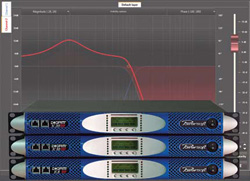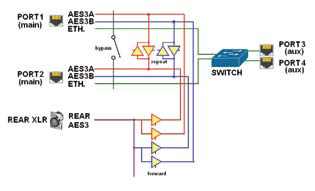
Modeling In Fashion
Armonía also offers an amplifier modeling feature that can address amplifier DSP and routing online or offline.
In offline mode, Armonía lets a systems engineer plan out an intended system of any size at the office (or even on a tour bus or plane) using virtual amplifiers for programming before connecting to a network.
This is very useful to the engineer to match amplifiers with appropriate DSP functions like crossover and EQ to loudspeakers before the system is on the truck. This also gives a clear picture of system resources needed for a particular event.
When used in online mode, system information can be sent or retrieved from the synchronized network. From here it is possible to copy an amplifier’s presets to the PC running Armonía and vice versa, including the very useful option of copying a set of presets to multiple amplifiers simultaneously.
All parameters designed in offline mode can be sent to the online actual amplifiers and, when used with the optional Powersoft Ethernet KAESOP board, a system engineer can extend the network to a virtually unlimited number of amplifiers through either auto-addressing with self-assigned IP addresses or end-user configurable IP addresses.
Making The Connection
Armonía is an Ethernet-based software package that offers full control of all amplifier parameters while accommodating AES3 audio on the same cable.
The software has built-in redundancy and extensive logging and alerting features designed to provide worry free operation for the sound engineer.
The platform delivers control and monitoring of all amplifier functions including AC mains current draw, headroom, protections and faults. The software also includes advanced grouping options.
Armonía is also compatible with both the latest offerings and many of our legacy products. Powersoft amplifiers can connect to a PC running Armonía in two ways: through an RS-485 serial connection or via Ethernet.
Amplifiers of the K and Duecanali Series can be equipped with either or both methods of connectivity while earlier remotely-controllable models have only an RS-485 connection. A system can be configured using both connection pathways simultaneously, extending the functional life of older amplifiers.

The range of network topologies which can be used in wiring a real system varies between the two communications methods. Ethernet provides a slightly greater degree of freedom, as standard IT network switches may be used to create multiple hub-and-spoke systems.
A looped Ethernet topology is also permissible, which will provide redundancy in the event of a network failure. An amplifier system using an RS-485 network can either be daisy-chained throughout or use the Powersoft PowerHub as a local switch.
Further, a wireless access point can be made directly to any Ethernet-enabled Powersoft amplifier, allowing wireless control via laptop or tablet PC.
Powersoft employs the IEEE 802.11n standard that currently yields faster, more reliable connectivity, extended usable range, plus offers an increase in available channels over earlier versions. This makes 802.11n far more suitable for use in fixed and tour sound applications where multiple amplifiers need to be addressed.
Ethernet networking also assures faster data refreshing and data exchange between each amplifier and the host computer, delivering real time monitoring of amplifier status, remote connection, mains presence, current draw, input signal, output voltage, internal temperature, short-circuit protection, clip and fault.
Armonía also offers real time control of amplifier on/ off/stand-by levels, solo, mute, sensitivity, max output voltage, max mains current draw, presets locking and input selection (digital/analog/KAESOP).
